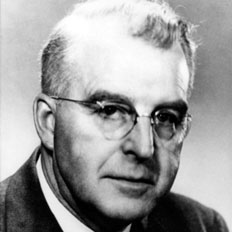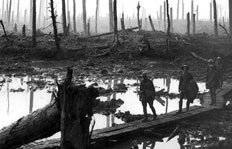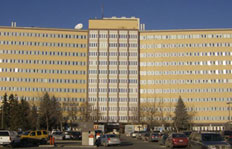Dr. Earle Parkhill Scarlett, 1896-1982
May 1, 2014

Dr. Scarlett was in a class of his own as Canada’s scholarly medical historian or “medical truant” as he liked to be called.
The ultimate business of our profession is not research into nerve pathways or devising some new operation, or untangling some abnormal cardiac rhythm but it is with life and human nature (Dr. Earle Parkhill Scarlett).
Early life
It could have been otherwise. Born near Portage La Prairie in Manitoba, he joined the Machine Gun Corps during World War I and survived both a mustard gas attack and a serious shrapnel injury to his neck. During his rehabilitation he met his guiding light, Sir William Osler. (Dr. Osler created the first medical residency program and was the first to include bedside clinical training as part of medical students’ education.)
After the war, he came back to Canada. Not sure what career to pursue, he canvassed a dozen friends of his father. Only two (both physicians) were happy with their professions.
He decided to study medicine at the University of Toronto, supporting himself with a summer job as a conductor on the CPR’s Soo line from Portal, Saskatchewan, to Banff, Alberta.
After several years of post-graduate training in United States in Internal Medicine, specializing in heart disease, he wanted to come back to Canada.
His mother suggested writing to R.B. Bennett, a Calgary MP and soon to be Prime Minister. Bennett connected him with his friend and fellow MP Dr. G.D. Stanley at Calgary’s Associate Clinic.
In 1930, Dr. Scarlett arrived in Calgary as the clinic’s first trained cardiologist (along with its first ECG machine).
Becoming a medical historian
Dr. Scarlett’s long-standing interest in medical history soon led to monthly evening sessions devoted to topics in medical history. Early in 1936, Dr. Stanley suggested that he and Dr. Scarlett start a medical history magazine, which their clinic would support.
They co-edited the Calgary Associate Clinic Historical Bulletin (CACHB) from 1936 to 1958. Dr. Scarlett’s column was the “Commonplace book of a medical reader.” Dr. Stanley usually focused on his own experiences during his pioneering days in High River and, after 1918, in Calgary.
All the members of the clinic wrote articles for the bulletin on a rotating basis. The 88 issues offer an irreplaceable window on early Alberta medicine, those who delivered it and how it was practiced.
Dr. Scarlett went on to manage the Associate Clinic before being nominated as the University of Alberta Chancellor (1952-58).
Resigning from practice in 1959, Dr. Scarlett took up to his second career as a medical historian full time, writing in three journals simultaneously and eight more sporadically.
His bibliography eventually included 451 works. Dr. Scarlett encouraged his colleagues and friends “to develop a library to serve as a starting point in a voyage of conception and delicious, diligent, indolence.”
Later years
The only physician on the board, Dr. Scarlett was a significant figure in establishing the faculty of medicine at the University of Calgary in 1966, the year the Foothills Hospital opened.
 He dedicated the hospital “to a fellowship as old as mankind, the history of service to the sick, and the teaching of medicine,” respectfully noting that “within these walls life begins and ends, here are reverence for life, a sense of the dignity of man, the distilled medical and scientific wisdom of years, and a shelter from the winds of illness.”
He dedicated the hospital “to a fellowship as old as mankind, the history of service to the sick, and the teaching of medicine,” respectfully noting that “within these walls life begins and ends, here are reverence for life, a sense of the dignity of man, the distilled medical and scientific wisdom of years, and a shelter from the winds of illness.”
Dr. Scarlett admitted he was spirited by “times winged chariot hurrying near; and yonder all about us lie, deserts of vast eternity,” but remained “the bemused boy, sitting in the back row of the cosmic theatre…listening and making notes - and wondering.”
Find out more
Get the whole story!
|
 Read the full profile of Dr. Scarlett in Dr. Robert Lampard's "Alberta's Medical History"
Read the full profile of Dr. Scarlett in Dr. Robert Lampard's "Alberta's Medical History"